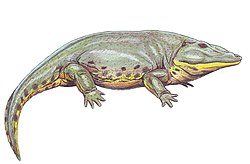| Trimerorhachidae | |
|---|---|
 | |
| Skull of Trimerorhachis insignis | |
| Scientific classification | |
| Domain: | Eukaryota |
| Kingdom: | Animalia |
| Phylum: | Chordata |
| Order: | † Temnospondyli |
| Suborder: | † Dvinosauria |
| Family: | † Trimerorhachidae Cope, 1882 |

Trimerorhachidae is a family of dvinosaurian temnospondyls, including Lafonius , Trimerorhachis , Procuhy and Neldasaurus . [1] [2] [3]
They were semiaquatic carnivores that lived from the Late Carboniferous to the Early Permian. [4]






